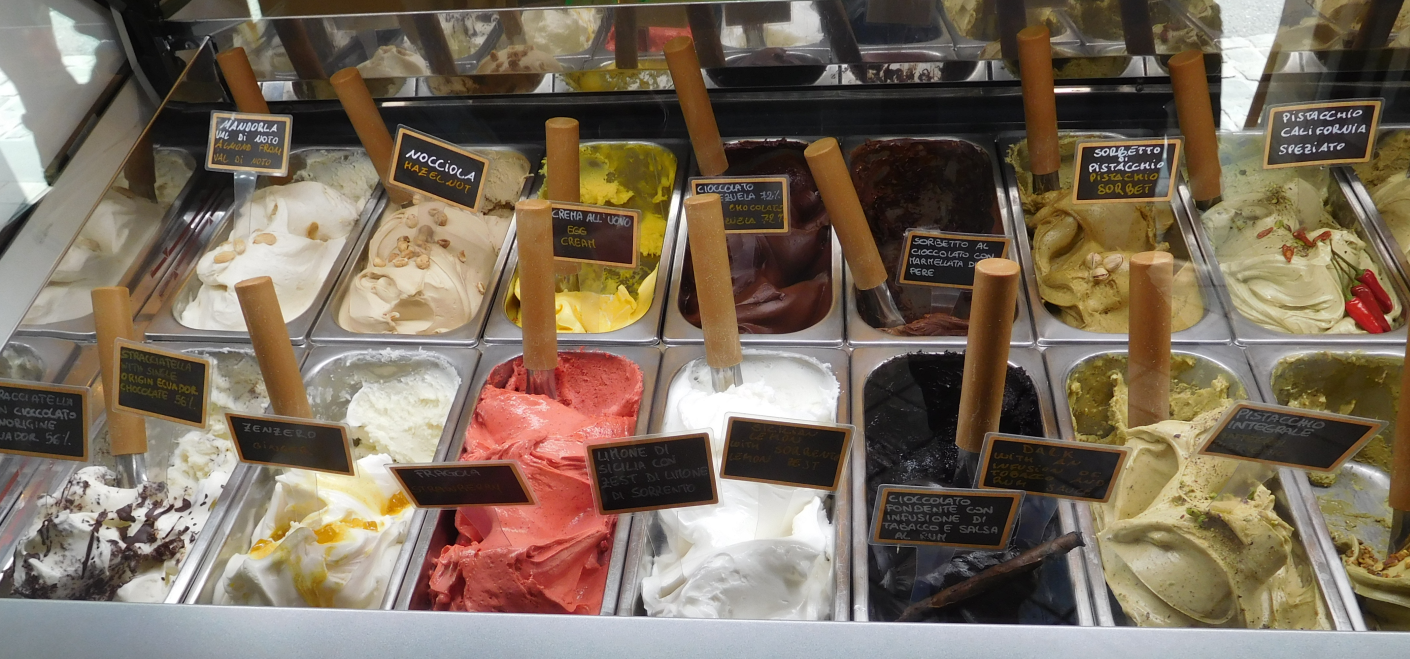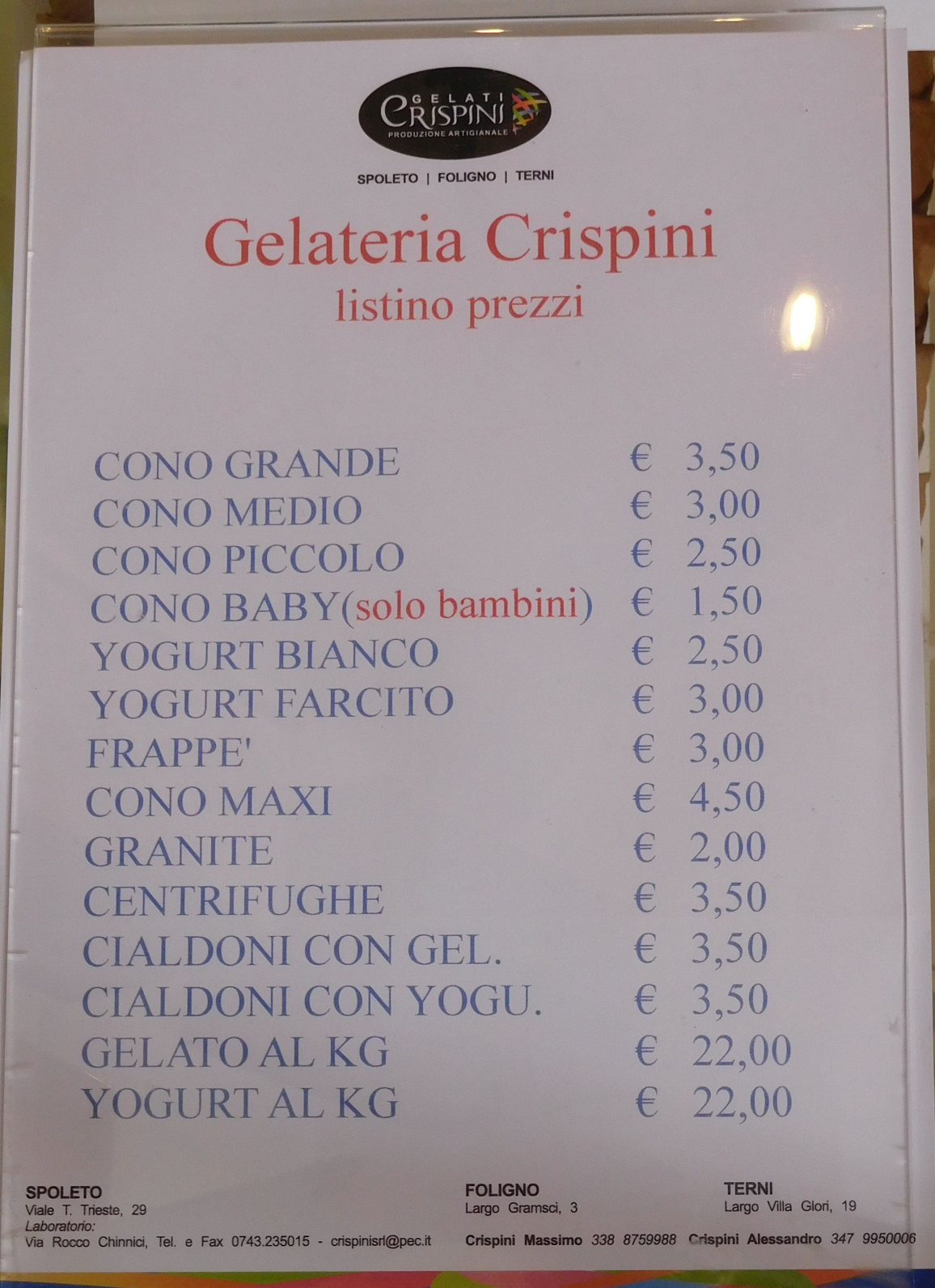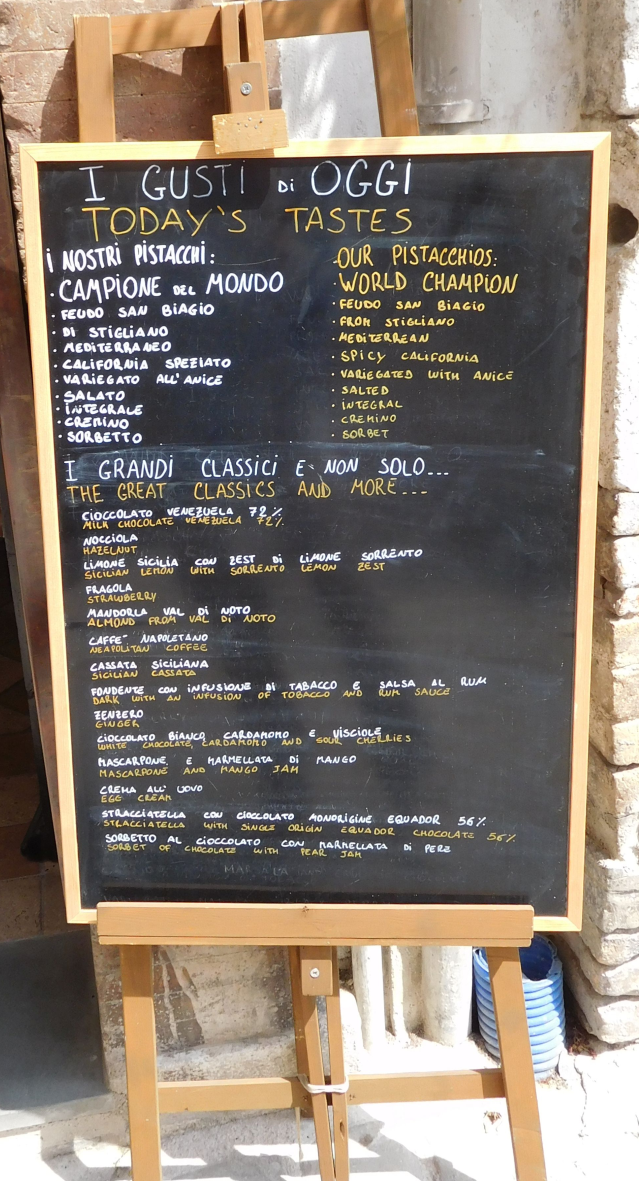Eating gelato in Italy
By Alan Zisman © 2019-07-03, updated 2023-09-26
French translation by Maiwenn Cosqueric, Spanish translation by Juegosiesta
Like pizza, gelato is one of Italy's treasures that now can be found worldwide. But - also like pizza - it's best experienced in Italy. In Italy, gelato is an affordable treat - and one of the few things, in a culture where coffee bars don't offer cups to take out, that you can eat while you walk down the street.
While it might seem that there's a gelato shop on every block in every town, not all gelato in Italy is created equal. There are some things to look for to help you get the best gelato.
Even though Google Translate will tell you that 'gelato' is Italian for 'ice cream', that's not quite correct. Unlike North American-style ice cream, gelato is made with milk, not cream, so it's got much less fat. And slower churning means less air in the mix - though we'll see that there are exceptions to this. But at its best, gelato is denser than ice cream and it's typically at a somewhat higher temperature - both of these result in more intense flavours. (See: Here's the difference between ice cream and gelato)
Unlike many Italian food and drink varieties, though, there's no regulation governing what can be sold as gelato. So - especially in popular tourist strips - there will be no shortage of shops featuring poor-quality, but eye-catching gelato. (2021-04-19: This may be changing - see: The Ice Cream Con: Italy Cracks Down On Air-Pumped Gelato)
First, look for a shop that claims its gelato is 'artigianale' - the same word is used to indicate craft beer. It's meant to suggest small batch, locally-made gelato as opposed to mass-produced factory-made stuff. This is not, however, fool-proof - while food names like 'parmeggiano' or 'prosciutto' are strictly defined, there are no regulations governing what can be called gelato artigianale. If you see 'fatto in casa', that will tell you the gelato is 'home-made' - made in the shop, rather than trucked in.
Next, take a look at the display counter. Here's a stock photo:

And here's a photo taken at the counter at Spoleto's prize-winning Gelateria Crispini:

Notice any differences? Here are two to look for:
-- while some of the flavours in Crispini's selection are bright, overalll they're not as garishly neon as in the top photo. Crispini specializes in a variety of pistacchio flavours - you can see one of them near the right on the bottom row. Note its dull grey-green colour - not the bright green we often associate with pistacchio ice cream. Lemon should be almost white, not bright yellow.
-- in the top photo, the piles of gelato are mounded high, making tall hills. That suggests a product enhanced with vegetable oil or emulsifiers or whipped with extra air.
Also look at how many varieties are on offer. A huge flavour list is not necessarily a good thing. Are the fruits in season?
How much should it cost?
Gelato in Italy is an affordable treat. Here's the price list of Spoleto's Gelateria Crispini (rated best in the world in 2017!):
 Some translations:
Some translations:
Listino Prezzi = Price list
Cono = Cone
Grande = large
Medio = medium
Piccolo = small
solo bambini = the baby-sized is for 'only little kids'
Notice the prices - a small cone costs €2.50 - and lets you choose scoops of two different flavours. That's generally plenty for me!
You'll often be offered whipped cream ('pana') on top of the gelato. I say no, but you're welcome to choose otherwise.
Many gelaterie (plural of gelateria) will give you a choice between gelato in a 'cono' (cone) or a 'coppa' (cup) - and some will offer a variety of cones, with fancy ones (for instance dipped in chocolate) costing more.
In some gelaterie - as in some caffe/bars, you need to pay first and get a ticket, handing it to the person who will serve up your gelato. In smaller, less crowded shops, you'll order your gelato, get served, and then pay.
But overall, gelato in Italy is an affordable treat.
Can you get a taste?
Any gelateria worth patronizing should offer little tastes - if they don't, go elsewhere! To ask for a taste in Italian, you could say 'posso assaggiare questo?' (Can I taste this one?) - Just remember that tasting two or three is okay, but more than that is not. And if there's a line-up behind you, try to make up your mind and order quickly!
 Flavours
Flavours
Don't limit yourself to gelaterie that list their flavours in English - and don't assume that the person behind the counter will speak more than a limited amount of English. Google Translate on your phone can help you with flavours but note that many Italian flavours don't have an English-language equivalent. Like 'Stracciatella' Here's the blackboard outside Spoleto's Gelateria Crispini - note that it does offer English translations. Their list changes frequently - but on this day included 9 (!) different pistacchi (pistachio) varieties. Other 'great classic' flavours include:
- Cioccolato: Chocolate
- Nocciola: Hazelnut
- Limone: Lemon
- Fragola: Strawberry
- Mandorla: Almond
- Caffe: Coffee
- Zenzero: Ginger
You'll also frequently see flavours like:
- Frutti del Bosco: literally 'fruits of the woods', it's more or less mixed berries
- Fior di Latte: literally 'flower of milk' it's unflavoured - sort of vanilla with no vanilla flavouring. You may also see it called Fior di Panna
- Puffo: literally 'smurf'; this is the blue stuff often called bubble-gum in North America. Maybe not for me, but kids like it.
- Gianguia: milk chocolate + hazelnuts
For more, see: Italian Gelato Flavors: What You Need to Know
Some personal favourites
In Florence, I like La Carraria (Piazza Nazario Sauro, 25/r, 50124 Firenze) - beside the second bridge upriver from the Ponte Vecchio, a short walk just across the river from the popular tourist areas. Good quality, low prices. I also like Gelateria Perche Non!, Via dei Tavolini, 19R near Piazza della Repubblica, and not just for the name (Why Not!)
In Spoleto, I've already mentioned Gelateria Crispini around the corner from the centrally-located Piazza del Mercato. Multiple pistaccio varieties plus other flavours as well.
In Venice, the quirky hole-in-the- wall Gelateria Alaska (Calle Larga de Bari, 1159, Venice - not far from the train station, across the canal in Santa Croce, follow the signs Per Rialto) is worth going out of your way for. Gelateria Nico is right on the waterfront in Dorsoduro (Fondamenta Zattere Al Ponte Lungo, 922), facing Giudecca - good gelato with a view.
In Matera, check out I Vizi degli Angeli (Via Domenico Ridola, 36) with unusual flavours like grapefruit and black pepper as well as more typical standards.
Grom is a chain, with locations in many larger and smaller Italian towns. Despite my prejudices against chains, Grom does a good job of serving quality gelato. Here's a list of locations.
Other links:
Older blog postings....
By Alan Zisman © 2019-07-03, updated 2023-09-26
French translation by Maiwenn Cosqueric, Spanish translation by Juegosiesta
Like pizza, gelato is one of Italy's treasures that now can be found worldwide. But - also like pizza - it's best experienced in Italy. In Italy, gelato is an affordable treat - and one of the few things, in a culture where coffee bars don't offer cups to take out, that you can eat while you walk down the street.
While it might seem that there's a gelato shop on every block in every town, not all gelato in Italy is created equal. There are some things to look for to help you get the best gelato.
Even though Google Translate will tell you that 'gelato' is Italian for 'ice cream', that's not quite correct. Unlike North American-style ice cream, gelato is made with milk, not cream, so it's got much less fat. And slower churning means less air in the mix - though we'll see that there are exceptions to this. But at its best, gelato is denser than ice cream and it's typically at a somewhat higher temperature - both of these result in more intense flavours. (See: Here's the difference between ice cream and gelato)
Unlike many Italian food and drink varieties, though, there's no regulation governing what can be sold as gelato. So - especially in popular tourist strips - there will be no shortage of shops featuring poor-quality, but eye-catching gelato. (2021-04-19: This may be changing - see: The Ice Cream Con: Italy Cracks Down On Air-Pumped Gelato)
First, look for a shop that claims its gelato is 'artigianale' - the same word is used to indicate craft beer. It's meant to suggest small batch, locally-made gelato as opposed to mass-produced factory-made stuff. This is not, however, fool-proof - while food names like 'parmeggiano' or 'prosciutto' are strictly defined, there are no regulations governing what can be called gelato artigianale. If you see 'fatto in casa', that will tell you the gelato is 'home-made' - made in the shop, rather than trucked in.
Next, take a look at the display counter. Here's a stock photo:

And here's a photo taken at the counter at Spoleto's prize-winning Gelateria Crispini:

Notice any differences? Here are two to look for:
-- while some of the flavours in Crispini's selection are bright, overalll they're not as garishly neon as in the top photo. Crispini specializes in a variety of pistacchio flavours - you can see one of them near the right on the bottom row. Note its dull grey-green colour - not the bright green we often associate with pistacchio ice cream. Lemon should be almost white, not bright yellow.
-- in the top photo, the piles of gelato are mounded high, making tall hills. That suggests a product enhanced with vegetable oil or emulsifiers or whipped with extra air.
Also look at how many varieties are on offer. A huge flavour list is not necessarily a good thing. Are the fruits in season?
How much should it cost?
Gelato in Italy is an affordable treat. Here's the price list of Spoleto's Gelateria Crispini (rated best in the world in 2017!):
 Some translations:
Some translations:Listino Prezzi = Price list
Cono = Cone
Grande = large
Medio = medium
Piccolo = small
solo bambini = the baby-sized is for 'only little kids'
Notice the prices - a small cone costs €2.50 - and lets you choose scoops of two different flavours. That's generally plenty for me!
You'll often be offered whipped cream ('pana') on top of the gelato. I say no, but you're welcome to choose otherwise.
Many gelaterie (plural of gelateria) will give you a choice between gelato in a 'cono' (cone) or a 'coppa' (cup) - and some will offer a variety of cones, with fancy ones (for instance dipped in chocolate) costing more.
In some gelaterie - as in some caffe/bars, you need to pay first and get a ticket, handing it to the person who will serve up your gelato. In smaller, less crowded shops, you'll order your gelato, get served, and then pay.
But overall, gelato in Italy is an affordable treat.
Can you get a taste?
Any gelateria worth patronizing should offer little tastes - if they don't, go elsewhere! To ask for a taste in Italian, you could say 'posso assaggiare questo?' (Can I taste this one?) - Just remember that tasting two or three is okay, but more than that is not. And if there's a line-up behind you, try to make up your mind and order quickly!
 Flavours
FlavoursDon't limit yourself to gelaterie that list their flavours in English - and don't assume that the person behind the counter will speak more than a limited amount of English. Google Translate on your phone can help you with flavours but note that many Italian flavours don't have an English-language equivalent. Like 'Stracciatella' Here's the blackboard outside Spoleto's Gelateria Crispini - note that it does offer English translations. Their list changes frequently - but on this day included 9 (!) different pistacchi (pistachio) varieties. Other 'great classic' flavours include:
- Cioccolato: Chocolate
- Nocciola: Hazelnut
- Limone: Lemon
- Fragola: Strawberry
- Mandorla: Almond
- Caffe: Coffee
- Zenzero: Ginger
You'll also frequently see flavours like:
- Frutti del Bosco: literally 'fruits of the woods', it's more or less mixed berries
- Fior di Latte: literally 'flower of milk' it's unflavoured - sort of vanilla with no vanilla flavouring. You may also see it called Fior di Panna
- Puffo: literally 'smurf'; this is the blue stuff often called bubble-gum in North America. Maybe not for me, but kids like it.
- Gianguia: milk chocolate + hazelnuts
For more, see: Italian Gelato Flavors: What You Need to Know
Some personal favourites
In Florence, I like La Carraria (Piazza Nazario Sauro, 25/r, 50124 Firenze) - beside the second bridge upriver from the Ponte Vecchio, a short walk just across the river from the popular tourist areas. Good quality, low prices. I also like Gelateria Perche Non!, Via dei Tavolini, 19R near Piazza della Repubblica, and not just for the name (Why Not!)
In Spoleto, I've already mentioned Gelateria Crispini around the corner from the centrally-located Piazza del Mercato. Multiple pistaccio varieties plus other flavours as well.
In Venice, the quirky hole-in-the- wall Gelateria Alaska (Calle Larga de Bari, 1159, Venice - not far from the train station, across the canal in Santa Croce, follow the signs Per Rialto) is worth going out of your way for. Gelateria Nico is right on the waterfront in Dorsoduro (Fondamenta Zattere Al Ponte Lungo, 922), facing Giudecca - good gelato with a view.
In Matera, check out I Vizi degli Angeli (Via Domenico Ridola, 36) with unusual flavours like grapefruit and black pepper as well as more typical standards.
Grom is a chain, with locations in many larger and smaller Italian towns. Despite my prejudices against chains, Grom does a good job of serving quality gelato. Here's a list of locations.
Other links:
- video: GET THE SCOOP! How I order GELATO when I'm in Italy
- How to spot good quality gelato in Italy - and how to suss out the fakes
- How to order gelato in Italian
- The Best Gelato in Italy
- The Best Gelato Shops in Italy
- The Best Gelato in Italy: Save These Recommendations
- The Best Gelaterias In Italy (And What To Order When You Visit)
- The 10 Best Places to Eat Gelato in Florence and CONO O COPPETTA? THE 10 BEST GELATO SHOPS IN FLORENCE
- The 12 Best Gelato Spots in Rome and A Gelato Tour of Rome and 10 of Rome's Best Gelato Shops
- Gelato madness! Where to get the best scoops in Venice or 9 Best Gelato Shops in Venice or 10 Best Gelato in Venice, Italy
- The Best Gelato in Bologna Italy
- The Best Gelato in Naples, Italy
- The Best Gelato in Verona Italy
- The Best Vegan Gelato In Italy
- A visit to Bologna's Carpigiani Gelato University
- Ordering Coffee in Rome
Older blog postings....
| About This Blog... I've been writing about computers, software, Internet and the rest of technology since 1992, including a 17 year (1995-2012) stint as 'High Tech Office' columnist for Business in Vancouver. This blog includes thoughts on technology, society, and anything else that might interest me. Comments, emailed to alan@zisman.ca are welcome - and may be published in whole or part. You can follow me on Facebook for notice of new blog postings. |
 |